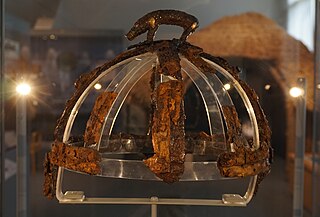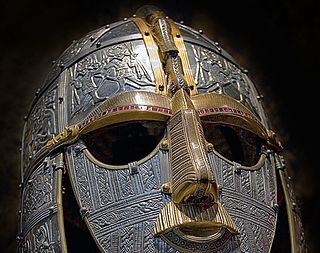
Sutton Hoo is the site of two Anglo-Saxon cemeteries dating from the 6th to 7th centuries near Woodbridge, Suffolk, England. Archaeologists have been excavating the area since 1938, when an undisturbed ship burial containing a wealth of Anglo-Saxon artifacts was discovered. The site is important in establishing the history of the Anglo-Saxon kingdom of East Anglia as well as illuminating the Anglo-Saxons during a period which lacks historical documentation.

Charles Francis Christopher Hawkes, FBA, FSA was an English archaeologist specialising in European prehistory. He was Professor of European Archaeology at the University of Oxford from 1946 to 1972.

The quoit brooch is a type of Anglo-Saxon brooch found from the 5th century and later during the Anglo-Saxon settlement of Britain that has given its name to the Quoit Brooch Style to embrace all types of Anglo-Saxon metalwork in the decorative style typical of the finest brooches. The brooches take their modern name from the rings thrown in the game of quoits, and have the form of a broad ring, or circle with an empty centre, usually in bronze or silver, and often highly decorated. The forms are in a very low relief, so contrasting with other early Anglo-Saxon styles, with detail added by shallow engraving or punching within the main shapes. Dots or dashes are often used to represent fur on the animal forms, as well as lines emphasizing parts of the body. They are fixed with a single, straight hinged pin like those of other Anglo-Saxon ring or Celtic brooches and are further defined by the presence of a slot and pin-stops on the ring.

The Benty Grange helmet is an Anglo-Saxon boar-crested helmet from the seventh century AD. It was excavated by Thomas Bateman in 1848 from a tumulus at the Benty Grange farm in Monyash in western Derbyshire. The grave had probably been looted by the time of Bateman's excavation, but still contained other high-status objects suggestive of a richly furnished burial, such as the fragmentary remains of a hanging bowl. The helmet is displayed at Sheffield's Weston Park Museum, which purchased it from Bateman's estate in 1893.

Finglesham is a village in the civil parish of Northbourne, and near Deal in Kent, England, which was the location of the Finglesham Anglo-Saxon cemetery, site of a seventh-century Anglo-Saxon archaeology find known as "Finglesham man," as described in 1965 by Sonia Chadwick Hawkes and Hilda Ellis Davidson. The village takes its name from the Old English Pengles-ham, meaning 'prince's manor', with the Anglo-Saxon cemetery containing a number of aristocratic burials. The population of the village is included in the civil parish of Northbourne.

The Sutton Hoo helmet is a decorated Anglo-Saxon helmet found during a 1939 excavation of the Sutton Hoo ship-burial. It was buried around the years c. 620–625 CE and is widely associated with an Anglo-Saxon leader, King Rædwald of East Anglia; its elaborate decoration may have given it a secondary function akin to a crown. The helmet was both a functional piece of armour and a decorative piece of metalwork. An iconic object from an archaeological find hailed as the "British Tutankhamen", it has become a symbol of the Early Middle Ages, "of Archaeology in general", and of England.

The Staffordshire Hoard is the largest hoard of Anglo-Saxon gold and silver metalwork yet found. It consists of almost 4,600 items and metal fragments, amounting to a total of 5.1 kg (11 lb) of gold, 1.4 kg (3 lb) of silver and some 3,500 pieces of garnet cloisonné jewellery. It is described by the historian Cat Jarman as "possibly the finest collection of early medieval artefacts ever discovered".

The Pioneer Helmet is an Anglo-Saxon boar-crested helmet from the late seventh century found in Wollaston, Northamptonshire, United Kingdom. It was discovered during a March 1997 excavation before the land was to be mined for gravel and was part of the grave of a young man. Other objects in the grave, such as a hanging bowl and a pattern welded sword, suggest that it was the burial mound of a high-status warrior.
Helena Francisca Hamerow, is an American archaeologist, best known for her work on the archeology of early medieval communities in Northwestern Europe. She is Professor of Early Medieval archaeology and former Head of the School of Archaeology, University of Oxford.
Edward Thurlow Leeds was an English archaeologist and museum curator. He was Keeper of the Ashmolean Museum from 1928 to 1945.
Audrey Lilian Meaney was an archaeologist and historian specialising in the study of Anglo-Saxon England. She published several books on the subject, including Gazetteer of Early Anglo-Saxon Burial Sites (1964) and Anglo-Saxon Amulets and Curing Stones (1981).

The Shorwell helmet is an Anglo-Saxon helmet from the early to mid-sixth century AD found near Shorwell on the Isle of Wight in southern England. It was one of the grave goods of a high-status Anglo-Saxon warrior, and was found with other objects such as a pattern-welded sword and hanging bowl. One of only six known Anglo-Saxon helmets, alongside those found at Benty Grange (1848), Sutton Hoo (1939), Coppergate (1982), Wollaston (1997), and Staffordshire (2009), it is the sole example to derive from the continental Frankish style rather than the contemporaneous Northern "crested helmets" used in England and Scandinavia.
Finglesham Anglo-Saxon cemetery is a place of burial that was used from the sixth to the eighth centuries CE. It is located adjacent to the village of Finglesham, near Sandwich in Kent, South East England. Belonging to the Anglo-Saxon period, it was part of the much wider tradition of burial in Early Anglo-Saxon England.

Many different weapons were created and used in Anglo-Saxon England between the fifth and eleventh centuries. Spears, used for piercing and throwing, were the most common weapon. Other commonplace weapons included the sword, axe, and knife—however, bows and arrows, as well as slings, were not frequently used by the Anglo-Saxons. For defensive purposes, the shield was the most common item used by warriors, although sometimes mail and helmets were used.

The Staffordshire helmet is an Anglo-Saxon helmet discovered in 2009 as part of the Staffordshire Hoard. It is part of the largest discovery of contemporary gold and silver metalwork in Britain, which contained more than 4,000 precious fragments, approximately a third of which came from a single high-status helmet. Following those found at Benty Grange (1848), Sutton Hoo (1939), Coppergate (1982), Wollaston (1997), and Shorwell (2004), it is only the sixth known Anglo-Saxon helmet.

The Guilden Morden boar is a sixth- or seventh-century Anglo-Saxon copper alloy figure of a boar that may have once served as the crest of a helmet. It was found around 1864 or 1865 in a grave in Guilden Morden, a village in the eastern English county of Cambridgeshire. There the boar attended a skeleton with other objects, including a small earthenware bead with an incised pattern, although the boar is all that now remains. Herbert George Fordham, whose father originally discovered the boar, donated it to the British Museum in 1904; as of 2018 it was on view in room 41.

Sonia Chadwick Hawkes was a British archaeologist specialising in early Anglo-Saxon archaeology. She led excavations on Anglo-Saxon cemeteries at Finglesham in Kent and Worthy Park in Hampshire. She was described by fellow medieval archaeologist Paul Ashbee as a "discerning systematiser of the great array of Anglo-Saxon grave furnishings".

Asthall barrow is a high-status Anglo-Saxon burial mound from the seventh century AD. It is located in Asthall, Oxfordshire, and was excavated in 1923 and 1924.
Vera Ivy Evison was a British archaeologist and academic, who specialed in Post-Roman Britain and early-Medieval England. She was Professor of Archaeology at Birkbeck College, University of London.
Tania Marguerite Dickinson is a British archaeologist specialising in early-medieval Britain. Dickinson undertook undergraduate study at St. Anne's College, Oxford and postgraduate study at the Institute of Archaeology (Oxford). Her doctoral thesis, titled The Anglo-Saxon burial sites of the upper Thames region, and their bearing on the history of Wessex, circa AD 400-700, was supervised by Sonia Chadwick Hawkes and Christopher Hawkes.














